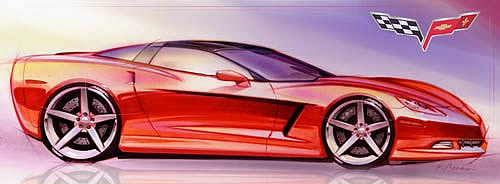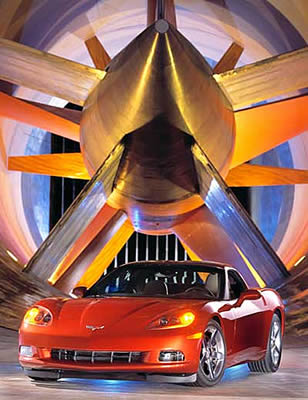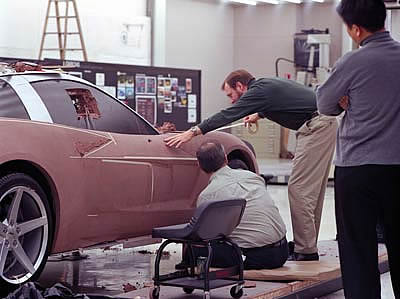Tom Peters Interview: Design of the 2005 Corvette C6 - Page 2 of 2
 |
Tom Peters: The Follow-Up Interview - Page 2 of 2
by Hib Halverson
©2004 Corvette Action Center
No use without permission
Released: August 1, 2004
CAC: Yeah. Law enforcement wants front plates so photo radar and photo red light cameras can ID your car. What was the greatest challenge in styling C6?
TP: "Actually, there were two. The first was deciding, debating sometimes, just what the right thematic balance for the Corvette was. It's always a struggle to balance overall program need or initiative against pure design intent or vision."
"Initially, we had a vision of what we thought the Corvette needed to be. Then, we factor-in some of the other elements, like, could we have done a different style upper, could it be a mid-engine, etc."
"Take the virtues of mid-engine vs. front-engine as an example. Relative to functionality, overall balance and all that, it's difficult to make a good case for mid-engine, unless you're willing to make dramatic tradeoffs in balance and versatility. I've been involved in those kinds of explorations on Corvette, however mid-engine was never considered for C6."
"Everybody wants to get involved, all the way up to the top. Everybody has an idea of what a new Corvette should be or what they anticipate it will be. Once you consider the original vision, elements based on need and/or initiative, elements which eventually are distilled out, marketing evaluations, guidance from design management and input from even higher level executives; you finally strike that thematic balance that works."
"Second: aerodynamics. With the theme set, we got very hot and heavy into aero development but even from the get-go, we had aerodynamics in mind. It's almost intuitive. You kind of lean towards a design which is more aerodynamic, at least visually. Experienced designers instinctively incorporate elements that have a positive effect on aerodynamics."
"Testing became very vigorous and intense. Dave Hill was adamant about reaching the new target (0.28 coefficient of drag). C5 was very good and C6 pushes aero to a higher level. This was even more of a challenge because shortening the vehicle and having wider tires is not directionally-correct aerodynamically."
CAC: You're saying that doing those two features actually make aerodynamics worse and you have to work harder to come back, then exceed the old car?
TP: Yes.
"Imagine the front profile: you have more flexibility surface-wise if you have more plan view and overhang (as did C5). You can transition the air around the sides or over the top of the nose. With a shorter front overhang, it's more of a blunted surface and you've got to transition the air around the sides much quicker because you just don't have the real estate. It goes from the front fascia, to the side right there at the corner, aerodynamics become very, very critical; a lot of tunnel time."
"Kirk Bennion, my Lead Designer, worked tirelessly on aero. He has probably more aerodynamic experience than even the aerodynamicists; I mean practical experience plus, he's got experience with aero on race cars. Interestingly, he doesn't have a degree in aerodynamic engineering but he's got street smarts from spending literally thousands of hours in the tunnel."
"Kirk's racing background and Corvette savvy helped us a lot when Dave had us try a slab side, like a Nascar NEXTEL Cup race car. That's optimal aero, but you lose all the juice; you lose the visual appeal which comes with surface development. That was, really frustrating because Hill was adamant, 'Ya gotta do it. Ya gotta try it.', but I think, down in his heart, even he knew we didn't really want to go out with a car like that, I believe that he wanted to explore what the limit of aerodynamic development of the C6 was. We just hated to put the straight body on this car. That was painful for me. Not having been through that kind of situation before, I was like, 'What's gonna really happen, here?'"
"Every square millimeter on that car changed. Aero affected every element on it. Design-wise, if we had a little more freedom from aero, maybe we could have tapered the rear, got more plan view in the rear or modified the height of the deck lid but I think the car looks really good. And it's very purposeful."
"Overall, the function in C6 was very important and it drove the asthetic so, to me, once we got the theme; it was getting through all the aerodynamics which was probably the most difficult."
CAC: The challenge was preserving what you think the design should be yet, also, meeting your aero targets?
TP: "Yeah."
"Now, it's not like the design process stopped and work became totally aero. There's some overlap, there. First, we're in the tunnel with a 1/3rd scale model, but, when you start going full-size in parallel as you approach the end of the design theme development, um, it starts getting really serious. Scale numbers get you in the ballpark. When you get into the full-size, aero-development model, you're expected to translate the results you get in the tunnel into the final-surface, release model that's in the studio as soon as possible."
If you weren't a computer geek to some extent, you wouldn't be reading the Corvette Action Center, so it might be interesting to examine how designers like Tom Peters and his team take the knowledge and experience they get testing the wind tunnel model and apply it to the model they're crafting in the studio.
Let's say the C6 aero team pulls the side of the front fascia out 2-mm. Of course, this is all pretend, so let's, also, say that gets them an 0.02 improvement in Cd. The designers go out to party (which they'd certainly do after a single, 2-mm change gets them 20 freakin' counts) and another group of engineers come in to electronically scan that area of the model using a photo-laser scanner which saves a digital version of the model to disk.
Over at the design studio, that data is transferred to another digital device, a computer-driven mill, which literally cuts-designers call it "grinding out" the studio's clay model to exactly the same profile as was applied to the model in the tunnel.
Once all the aero and studio work is done, the full-sized models are scanned again and the "product" the design team supplies to those tasked with turning Tom Peters' work into a real car is a "math model", a bunch of files on computer storage media.
TP: "The model in the studio is a 'verification cut'. We look at it and say, 'Yep. This is what we expected' or, 'no, this ain't it' and we've got to go back in the math and modify it a little more."
"At the end of the day, we're not making a virtual product, we're making a Corvette. We've gone back and forth on the need, today, for clay models. There are those who say we don't need them but, I've been through all that and I can tell you, the math information and ways of representing it are just not robust enough for us to have the confidence that what we see on the screen is always what we're going to get on the road. I can tell you that there have been many cases were I see many aspects of a design on the computer but, when we grind it out, I'm surprised."
"There are certain situations such as atmospheric perspective, physical presence of a large object, the difference between a car in two dimensions and three where just being able to walk around a 3D, full-sized property more closely representing the design is far more convincing, far more understandable. There's no room for interpretation because the real thing is right there in front of you."
"It's not to say you can't do some programs all-math. It depends on the circumstances and the resources you have available. To me, what it comes down to is: you use the best and most appropriate tool at the time based on the requirement of the project.
"I'm working on a program right now (In addition to his duties on the C6, Peters is currently the Director of Design for GM's mid-sized trucks) where we're using minimal hand-sculpting on the full-size (model). In Corvette's case, we felt it was very important to hand-sculpt. What you do in hand-sculpting those beautiful, subtle surface transitions again, I'm not saying that is impossible, but it is difficult to execute on the computer. It's easier for us to do it manually. We hand-picked the sculptors that were on C6. They were some of the best at GM. There's a magic, a touch of artistic sprit that somehow gets into the sculpture if it's done by hand."
CAC: It's pretty hard to install spirit and what you've called "juice" with a computer.
TP: "I don't want to say it's impossible, but it's extremely difficult. It has been done, but I think you can get to it a lot sooner by doing it by hand. Then get it into math and you can do whatever you want with it."
"Once again, the right tool at the right time."
CAC: During aerodynamic development of the C6, what was the single biggest gain?
TP: "In the case of this vehicle, it was so refined when we brought it in, based on where we were with the C5, we were really splitting hairs. You're going for a stack-up of base hits, maybe an occasional double, but triples or a home run? You're just not going to find them. So you're getting base hits all over the vehicle, here-and-there, and it's the accumulation of those small advances that gets you to the good number."
CAC: The car's already pretty good, so each thing you do has diminished return?
TP: "Exactly. The closer you get to that .28Cd., it's like, aw man, you're really squeezing blood out of a rock, ya know?"
CAC: That's where it is now?
TP: "When we left off (at the point when the design was frozen for release in '02), it was a .28, I know they're still trying to get that optimized. With respect to aerodynamics, it's always a challenge to translate what you learn in the wind tunnel into repeatable, production cars."
Right at deadline, David Hill told us in an interview you'll read later in Corvette Action Center's C6 coverage that the production Cd is 0.286, six counts short of the goal.
CAC: Media information claims it was the '63-'67 Corvette design which influenced you but, the more I look at that car, the more I see more of the '68-'82, C3 in your design, especially the way the fenders peak.
TP: "We looked at both, but the primary influence was C2. The difference in fender peak slopes was not a conscious decision to emulate the '68. It was more the need to make an overall shear-surfaced car which was an inch-narrower. I wanted more fender definition and the natural progression would be to have the fender slopes vary. For general philosophy, I was more influenced by the '63-'67."
"Initially, we actually wanted even more emphasis on some of those shapes, but Dave was, like,'We made so many gains on C5 with downward vision, the guys driving the cars in competition really appreciate that and we don't want to go backwards.' We pushed it farther than he wanted to go, really, but once he got in the car; he thought it was a pretty good balance."
Back to "C6 Naked and Exposed - The Sequel: Finally...We Drive It!!!"
 |



